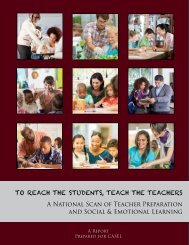Future Ready Learning
7m3sdJ
7m3sdJ
You also want an ePaper? Increase the reach of your titles
YUMPU automatically turns print PDFs into web optimized ePapers that Google loves.
Education data systems do not always maximize the use of interoperability standards that would<br />
enable easy and secure sharing of information with educators, schools, districts, states, students,<br />
and their families. As a result, educators are missing out on significant opportunities to use<br />
data to improve and personalize learning. With improved educational data systems, leaders can<br />
leverage aggregate data to improve the quality and effectiveness of technology-enabled learning<br />
tools and resources.<br />
For example, it is now possible to gather data during formative and summative assessments<br />
that can be used to create personalized digital learning experiences. In addition, teachers can<br />
use these data to inform interventions and decisions about how to engage individual students;<br />
personalize learning; and create more engaging, relevant, and accessible learning experiences for<br />
all learners.<br />
Assessment data can be made available directly to students. When they have access to their<br />
data, students can play a larger role in choosing their own learning pathways. 8 The data also<br />
can be made available to family members so students’ advocates can play a more active role<br />
in supporting their children’s education. Moreover, data can be used to support teachers’<br />
efforts—individually or in teams, departments, or schools—to improve professional practice<br />
and learning. 9 For personalized learning systems to reach their full potential, data systems and<br />
learning platforms should include seamless interoperability with a focus on data security and<br />
issues related to privacy.<br />
In many cases, pre-service teaching candidates do not receive sufficient instruction on understanding<br />
and using data. At the same time, in-service teachers can benefit from ongoing professional<br />
development on the integration of technology to enhance their teaching. According to the<br />
Data Quality Campaign, as of February 2014, just 19 states included the demonstration of data<br />
literacy skills as a requirement for teacher licensure. 10 Although data from technology-based<br />
assessments and data systems hold great potential, they are meaningful only when educators use<br />
them effectively. Teachers deserve ongoing support to strengthen their skills in how to use data<br />
to meet the needs of students better.<br />
Addressing these challenges will take a three-pronged approach: (1) preparing and supporting<br />
educators in realizing the full potential of using assessment data, (2) encouraging the development<br />
of data assessment tools that are more intuitive and include visualizations that clearly<br />
indicate what the data mean for instruction, and (3) ensuring the security and privacy of student<br />
data within these systems.<br />
For a more complete discussion of student data safety and privacy, see Section 5: Infrastructure.<br />
How Technology Transforms Assessment<br />
Technology can help us imagine and redefine assessment in a variety of ways. These tools<br />
can provide unobtrusive measurements for learners who are designing and building products,<br />
conducting experiments using mobile devices, and manipulating parameters in simulations.<br />
Problems can be situated in real-world environments, where students perform tasks, or include<br />
multi-stage scenarios that simulate authentic, progressive engagement with the subject matter.<br />
Teachers can access information on student progress and learning throughout the school day,<br />
which allows them to adapt instruction to personalize learning or intervene to address particular<br />
learning shortfalls. The unique attributes of technology-based assessments that enable these<br />
activities include the following.<br />
OFFICE OF Educational Technology<br />
54



